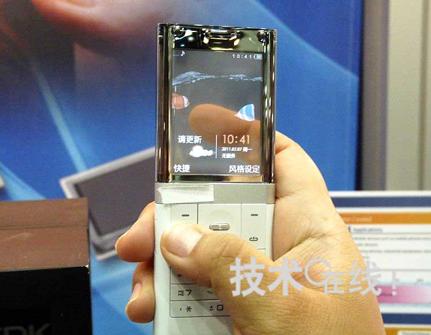 TDK announced the structure of its transparent OLED panel that has been in mass production since March 2011. The panel is characterized by the object behind it that is visible through the surface energy. Using passive matrix, the screen size is 2.4 inches. The pixel is QVGA (240X320 pixels) and can realize color display. The panel has been adopted by Lenovo mobile phones in China. The mobile phone was launched on the market in March 2011. In addition, TDK demonstrated the prototype of the transparent OLED panel at "CEATEC JAPAN" in October 2010.
TDK announced the structure of its transparent OLED panel that has been in mass production since March 2011. The panel is characterized by the object behind it that is visible through the surface energy. Using passive matrix, the screen size is 2.4 inches. The pixel is QVGA (240X320 pixels) and can realize color display. The panel has been adopted by Lenovo mobile phones in China. The mobile phone was launched on the market in March 2011. In addition, TDK demonstrated the prototype of the transparent OLED panel at "CEATEC JAPAN" in October 2010. The OLED layer of the OLED panel is sandwiched between the anode and the cathode, and emits light by allowing current to flow through the OLED layer. In general, a transparent electrode is used for the anode and a metal electrode is used for the cathode. Light is emitted from the anode surface. Although there have been precedents for trial production of transparent OLED panels, most of the cathodes use transparent electrodes.
There are two problems with the previous practice. One is that it is difficult to form transparent electrodes such as oxides on the OLED layer, and mass production technology cannot be established. The other is that the light emitted by the OLED layer is emitted not only from the anode surface but also from the cathode surface. Therefore, the display content can be seen not only from the surface of the panel but also from the back surface thereof. Taking the main screen of the mobile phone as an example, the user "does not want to see the screen display content from the back."
Therefore, TDK has developed a new construction panel that can avoid the above problems. First, in order to use the existing production technology to achieve mass production as soon as possible, the cathode uses a metal electrode directly. On this basis, in order to be able to see the latter, the pixels are not all of the cathodes, but the line width of the cathodes is thinned to cover only a part of the pixels. Using the part that is not covered by the cathode, a transparent function that can be seen behind is achieved. TDK named this panel structure "fine wire electrode configuration." Only part of the pixels of the OLED layer that are covered by the cathode emits light. However, because the cathode is an opaque metal electrode, light emitted from the OLED layer only exits from the anode surface. Therefore, it is difficult to see the display from the back of the monitor.
For practical use as early as possible, TDK has not used a blue material with a short lifetime, but has adopted a color display method that combines a white OLED and a color filter. In general, the use of color filters will reduce the panel's transmittance. However, as with the cathode, the color filter has also been reduced in line width, covering only the structure of a part of the pixels, so the influence of the drop in the transmittance of the panel is small. The brightness of the transparent OLED panel this time is 150cd/m2, and the transmittance is 40%.
Currently, TDK is manufacturing this transparent OLED panel at TDK Micro Device in the northern city of Ibaraki Prefecture. There are two production lines. Although once forced to stop production after the Great East Japan Earthquake on March 11, the two production lines have resumed operation on April 8 and May 9 respectively.
PC Bluetooth Keyboard
BETOP TECHNOLOGY CO.,LTD , http://www.betopparts.com